Impact of Female Genital Mutilation on Women's Health (18-35)
VerifiedAdded on 2020/10/22
|19
|4861
|170
Report
AI Summary
This research proposal investigates the impact of Female Genital Mutilation (FGM) on the psychological and physical health and wellbeing of women aged 18-35. The introduction provides background on FGM, highlighting its cultural origins and global prevalence, including its emergence in Europe and America due to migration. It emphasizes the need for healthcare professionals to understand the experiences of FGM victims to provide appropriate care. The rationale details the importance of understanding both the psychological and physical impacts, citing studies and outlining the different types of FGM and their varied consequences. The literature review explores the prevalence of FGM, referencing statistical data from UNICEF and WHO, as well as the legal context. The study justification underscores the rising number of FGM cases in the UK and the need for health professionals to understand the health consequences of FGM. The objectives of the research are to examine the psychological and physical effects of FGM, the interventions recommended, and the best ways to manage FGM victims. The proposal adopts a holistic research structure to combine the research on both physical and psychological effects of FGM on the victims’ life course experiences.

RESEARCH PROPOSAL
Paraphrase This Document
Need a fresh take? Get an instant paraphrase of this document with our AI Paraphraser

Research Question
How has FGM impacted on the psychological and physical
health-wellbeing of women aged 18-35 who have
experienced it?
How has FGM impacted on the psychological and physical
health-wellbeing of women aged 18-35 who have
experienced it?
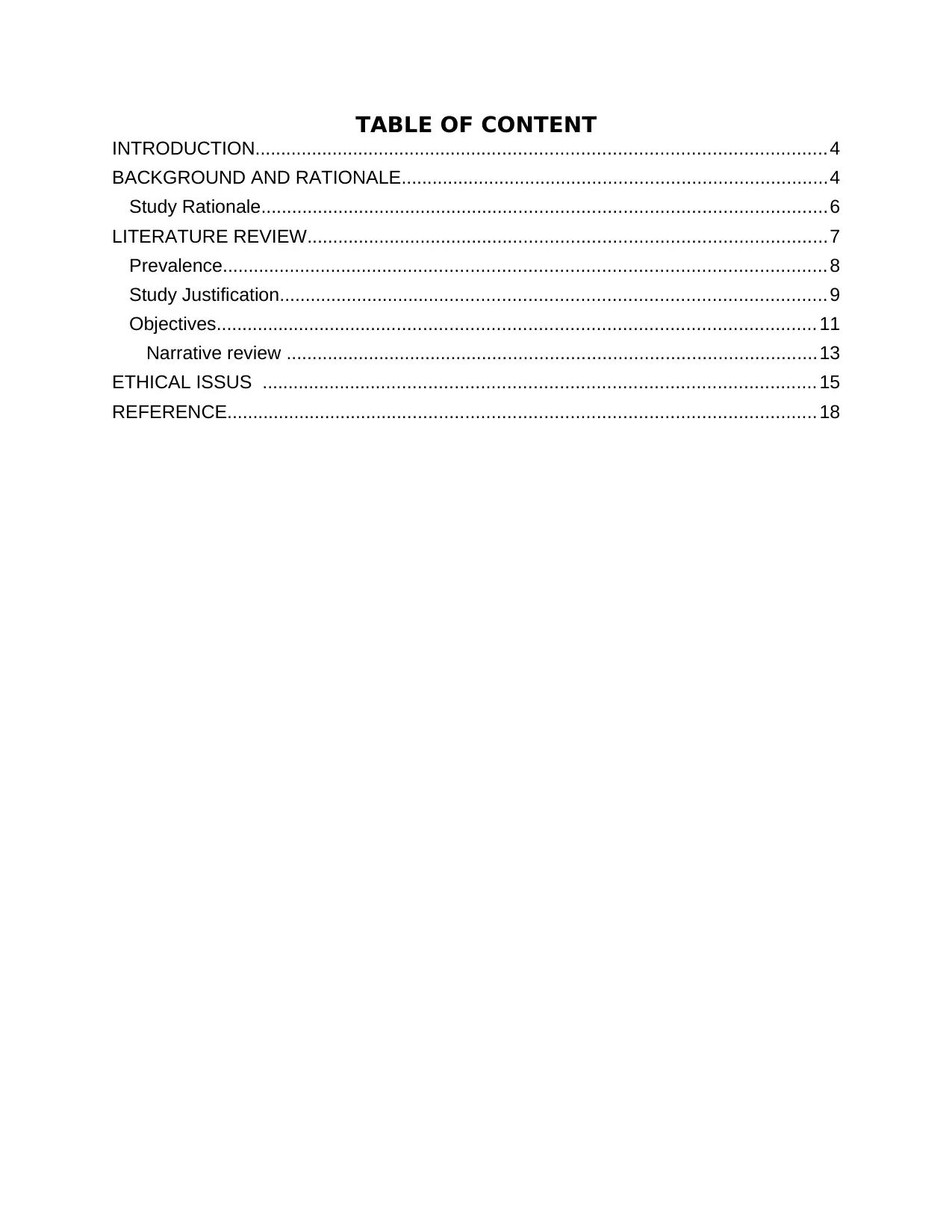
TABLE OF CONTENT
INTRODUCTION..............................................................................................................4
BACKGROUND AND RATIONALE..................................................................................4
Study Rationale.............................................................................................................6
LITERATURE REVIEW....................................................................................................7
Prevalence....................................................................................................................8
Study Justification.........................................................................................................9
Objectives................................................................................................................... 11
Narrative review ......................................................................................................13
ETHICAL ISSUS .......................................................................................................... 15
REFERENCE................................................................................................................. 18
INTRODUCTION..............................................................................................................4
BACKGROUND AND RATIONALE..................................................................................4
Study Rationale.............................................................................................................6
LITERATURE REVIEW....................................................................................................7
Prevalence....................................................................................................................8
Study Justification.........................................................................................................9
Objectives................................................................................................................... 11
Narrative review ......................................................................................................13
ETHICAL ISSUS .......................................................................................................... 15
REFERENCE................................................................................................................. 18
⊘ This is a preview!⊘
Do you want full access?
Subscribe today to unlock all pages.

Trusted by 1+ million students worldwide
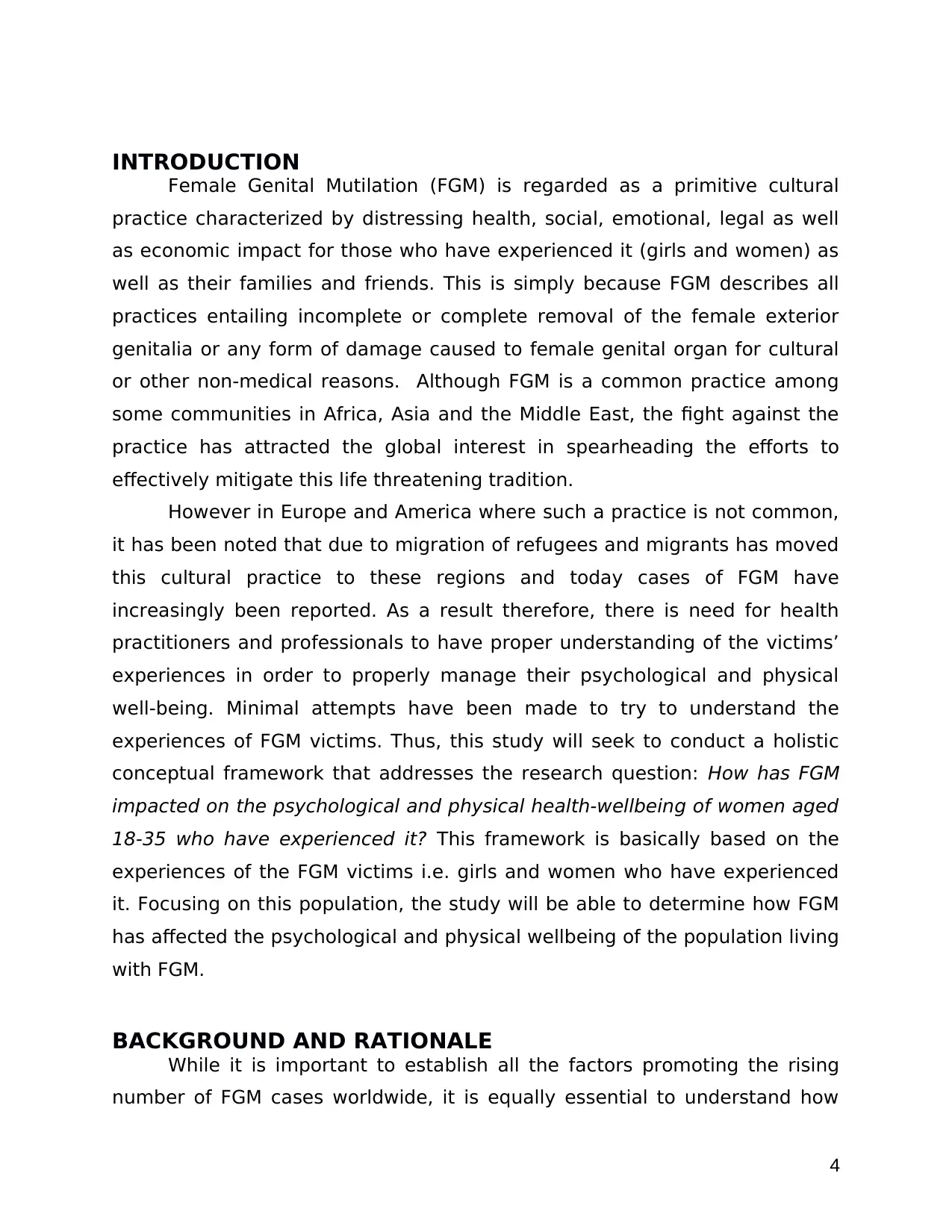
INTRODUCTION
Female Genital Mutilation (FGM) is regarded as a primitive cultural
practice characterized by distressing health, social, emotional, legal as well
as economic impact for those who have experienced it (girls and women) as
well as their families and friends. This is simply because FGM describes all
practices entailing incomplete or complete removal of the female exterior
genitalia or any form of damage caused to female genital organ for cultural
or other non-medical reasons. Although FGM is a common practice among
some communities in Africa, Asia and the Middle East, the fight against the
practice has attracted the global interest in spearheading the efforts to
effectively mitigate this life threatening tradition.
However in Europe and America where such a practice is not common,
it has been noted that due to migration of refugees and migrants has moved
this cultural practice to these regions and today cases of FGM have
increasingly been reported. As a result therefore, there is need for health
practitioners and professionals to have proper understanding of the victims’
experiences in order to properly manage their psychological and physical
well-being. Minimal attempts have been made to try to understand the
experiences of FGM victims. Thus, this study will seek to conduct a holistic
conceptual framework that addresses the research question: How has FGM
impacted on the psychological and physical health-wellbeing of women aged
18-35 who have experienced it? This framework is basically based on the
experiences of the FGM victims i.e. girls and women who have experienced
it. Focusing on this population, the study will be able to determine how FGM
has affected the psychological and physical wellbeing of the population living
with FGM.
BACKGROUND AND RATIONALE
While it is important to establish all the factors promoting the rising
number of FGM cases worldwide, it is equally essential to understand how
4
Female Genital Mutilation (FGM) is regarded as a primitive cultural
practice characterized by distressing health, social, emotional, legal as well
as economic impact for those who have experienced it (girls and women) as
well as their families and friends. This is simply because FGM describes all
practices entailing incomplete or complete removal of the female exterior
genitalia or any form of damage caused to female genital organ for cultural
or other non-medical reasons. Although FGM is a common practice among
some communities in Africa, Asia and the Middle East, the fight against the
practice has attracted the global interest in spearheading the efforts to
effectively mitigate this life threatening tradition.
However in Europe and America where such a practice is not common,
it has been noted that due to migration of refugees and migrants has moved
this cultural practice to these regions and today cases of FGM have
increasingly been reported. As a result therefore, there is need for health
practitioners and professionals to have proper understanding of the victims’
experiences in order to properly manage their psychological and physical
well-being. Minimal attempts have been made to try to understand the
experiences of FGM victims. Thus, this study will seek to conduct a holistic
conceptual framework that addresses the research question: How has FGM
impacted on the psychological and physical health-wellbeing of women aged
18-35 who have experienced it? This framework is basically based on the
experiences of the FGM victims i.e. girls and women who have experienced
it. Focusing on this population, the study will be able to determine how FGM
has affected the psychological and physical wellbeing of the population living
with FGM.
BACKGROUND AND RATIONALE
While it is important to establish all the factors promoting the rising
number of FGM cases worldwide, it is equally essential to understand how
4
Paraphrase This Document
Need a fresh take? Get an instant paraphrase of this document with our AI Paraphraser
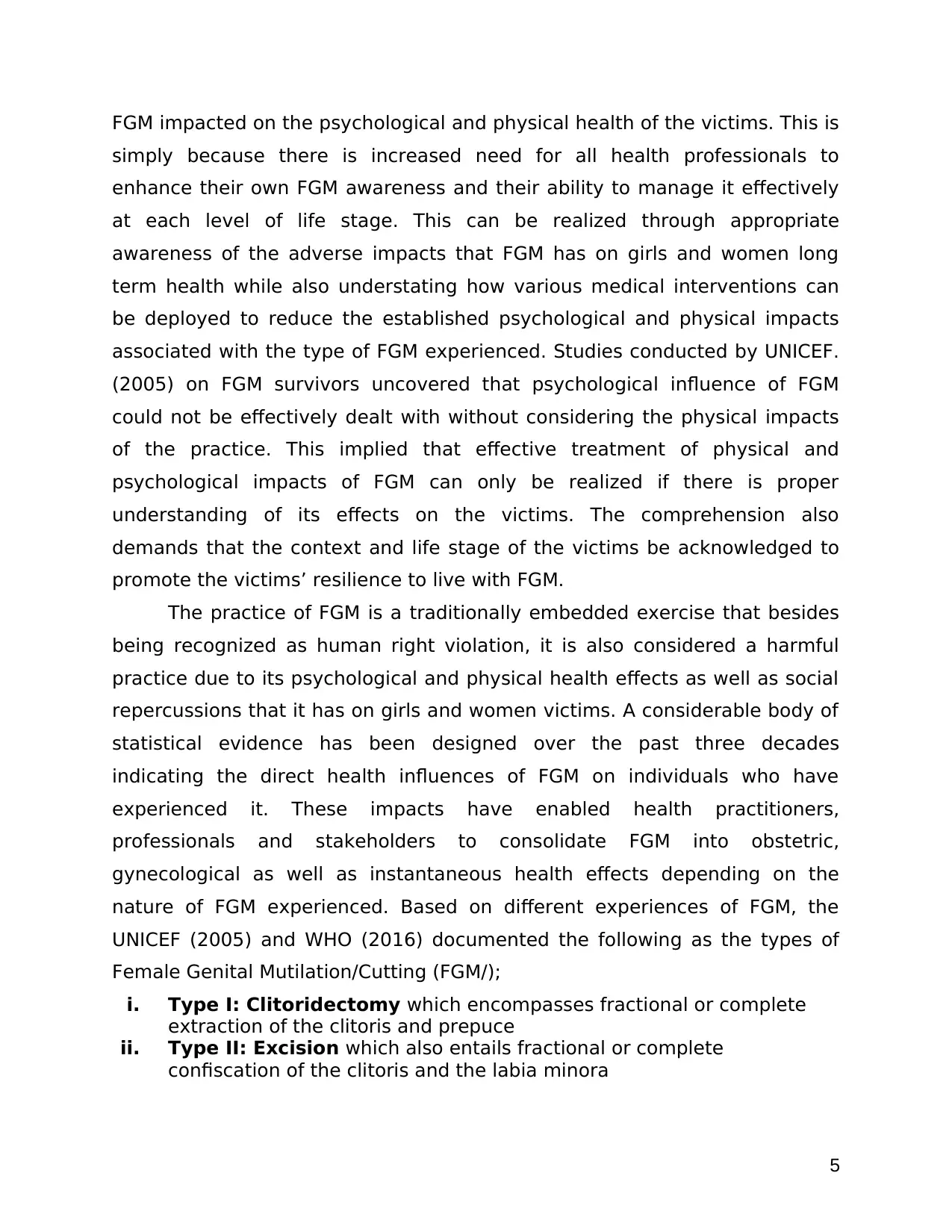
FGM impacted on the psychological and physical health of the victims. This is
simply because there is increased need for all health professionals to
enhance their own FGM awareness and their ability to manage it effectively
at each level of life stage. This can be realized through appropriate
awareness of the adverse impacts that FGM has on girls and women long
term health while also understating how various medical interventions can
be deployed to reduce the established psychological and physical impacts
associated with the type of FGM experienced. Studies conducted by UNICEF.
(2005) on FGM survivors uncovered that psychological influence of FGM
could not be effectively dealt with without considering the physical impacts
of the practice. This implied that effective treatment of physical and
psychological impacts of FGM can only be realized if there is proper
understanding of its effects on the victims. The comprehension also
demands that the context and life stage of the victims be acknowledged to
promote the victims’ resilience to live with FGM.
The practice of FGM is a traditionally embedded exercise that besides
being recognized as human right violation, it is also considered a harmful
practice due to its psychological and physical health effects as well as social
repercussions that it has on girls and women victims. A considerable body of
statistical evidence has been designed over the past three decades
indicating the direct health influences of FGM on individuals who have
experienced it. These impacts have enabled health practitioners,
professionals and stakeholders to consolidate FGM into obstetric,
gynecological as well as instantaneous health effects depending on the
nature of FGM experienced. Based on different experiences of FGM, the
UNICEF (2005) and WHO (2016) documented the following as the types of
Female Genital Mutilation/Cutting (FGM/);
i. Type I: Clitoridectomy which encompasses fractional or complete
extraction of the clitoris and prepuce
ii. Type II: Excision which also entails fractional or complete
confiscation of the clitoris and the labia minora
5
simply because there is increased need for all health professionals to
enhance their own FGM awareness and their ability to manage it effectively
at each level of life stage. This can be realized through appropriate
awareness of the adverse impacts that FGM has on girls and women long
term health while also understating how various medical interventions can
be deployed to reduce the established psychological and physical impacts
associated with the type of FGM experienced. Studies conducted by UNICEF.
(2005) on FGM survivors uncovered that psychological influence of FGM
could not be effectively dealt with without considering the physical impacts
of the practice. This implied that effective treatment of physical and
psychological impacts of FGM can only be realized if there is proper
understanding of its effects on the victims. The comprehension also
demands that the context and life stage of the victims be acknowledged to
promote the victims’ resilience to live with FGM.
The practice of FGM is a traditionally embedded exercise that besides
being recognized as human right violation, it is also considered a harmful
practice due to its psychological and physical health effects as well as social
repercussions that it has on girls and women victims. A considerable body of
statistical evidence has been designed over the past three decades
indicating the direct health influences of FGM on individuals who have
experienced it. These impacts have enabled health practitioners,
professionals and stakeholders to consolidate FGM into obstetric,
gynecological as well as instantaneous health effects depending on the
nature of FGM experienced. Based on different experiences of FGM, the
UNICEF (2005) and WHO (2016) documented the following as the types of
Female Genital Mutilation/Cutting (FGM/);
i. Type I: Clitoridectomy which encompasses fractional or complete
extraction of the clitoris and prepuce
ii. Type II: Excision which also entails fractional or complete
confiscation of the clitoris and the labia minora
5
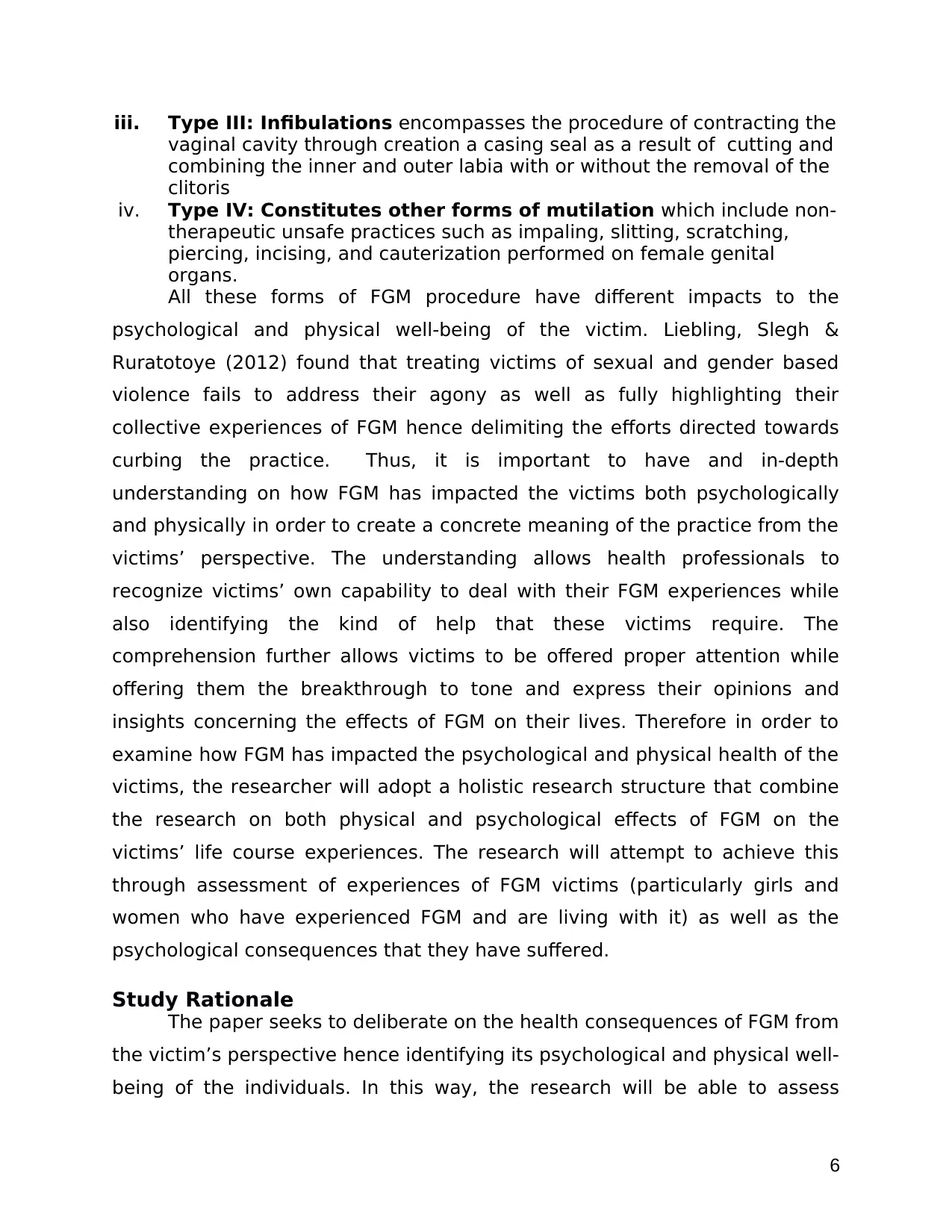
iii. Type III: Infibulations encompasses the procedure of contracting the
vaginal cavity through creation a casing seal as a result of cutting and
combining the inner and outer labia with or without the removal of the
clitoris
iv. Type IV: Constitutes other forms of mutilation which include non-
therapeutic unsafe practices such as impaling, slitting, scratching,
piercing, incising, and cauterization performed on female genital
organs.
All these forms of FGM procedure have different impacts to the
psychological and physical well-being of the victim. Liebling, Slegh &
Ruratotoye (2012) found that treating victims of sexual and gender based
violence fails to address their agony as well as fully highlighting their
collective experiences of FGM hence delimiting the efforts directed towards
curbing the practice. Thus, it is important to have and in-depth
understanding on how FGM has impacted the victims both psychologically
and physically in order to create a concrete meaning of the practice from the
victims’ perspective. The understanding allows health professionals to
recognize victims’ own capability to deal with their FGM experiences while
also identifying the kind of help that these victims require. The
comprehension further allows victims to be offered proper attention while
offering them the breakthrough to tone and express their opinions and
insights concerning the effects of FGM on their lives. Therefore in order to
examine how FGM has impacted the psychological and physical health of the
victims, the researcher will adopt a holistic research structure that combine
the research on both physical and psychological effects of FGM on the
victims’ life course experiences. The research will attempt to achieve this
through assessment of experiences of FGM victims (particularly girls and
women who have experienced FGM and are living with it) as well as the
psychological consequences that they have suffered.
Study Rationale
The paper seeks to deliberate on the health consequences of FGM from
the victim’s perspective hence identifying its psychological and physical well-
being of the individuals. In this way, the research will be able to assess
6
vaginal cavity through creation a casing seal as a result of cutting and
combining the inner and outer labia with or without the removal of the
clitoris
iv. Type IV: Constitutes other forms of mutilation which include non-
therapeutic unsafe practices such as impaling, slitting, scratching,
piercing, incising, and cauterization performed on female genital
organs.
All these forms of FGM procedure have different impacts to the
psychological and physical well-being of the victim. Liebling, Slegh &
Ruratotoye (2012) found that treating victims of sexual and gender based
violence fails to address their agony as well as fully highlighting their
collective experiences of FGM hence delimiting the efforts directed towards
curbing the practice. Thus, it is important to have and in-depth
understanding on how FGM has impacted the victims both psychologically
and physically in order to create a concrete meaning of the practice from the
victims’ perspective. The understanding allows health professionals to
recognize victims’ own capability to deal with their FGM experiences while
also identifying the kind of help that these victims require. The
comprehension further allows victims to be offered proper attention while
offering them the breakthrough to tone and express their opinions and
insights concerning the effects of FGM on their lives. Therefore in order to
examine how FGM has impacted the psychological and physical health of the
victims, the researcher will adopt a holistic research structure that combine
the research on both physical and psychological effects of FGM on the
victims’ life course experiences. The research will attempt to achieve this
through assessment of experiences of FGM victims (particularly girls and
women who have experienced FGM and are living with it) as well as the
psychological consequences that they have suffered.
Study Rationale
The paper seeks to deliberate on the health consequences of FGM from
the victim’s perspective hence identifying its psychological and physical well-
being of the individuals. In this way, the research will be able to assess
6
⊘ This is a preview!⊘
Do you want full access?
Subscribe today to unlock all pages.

Trusted by 1+ million students worldwide
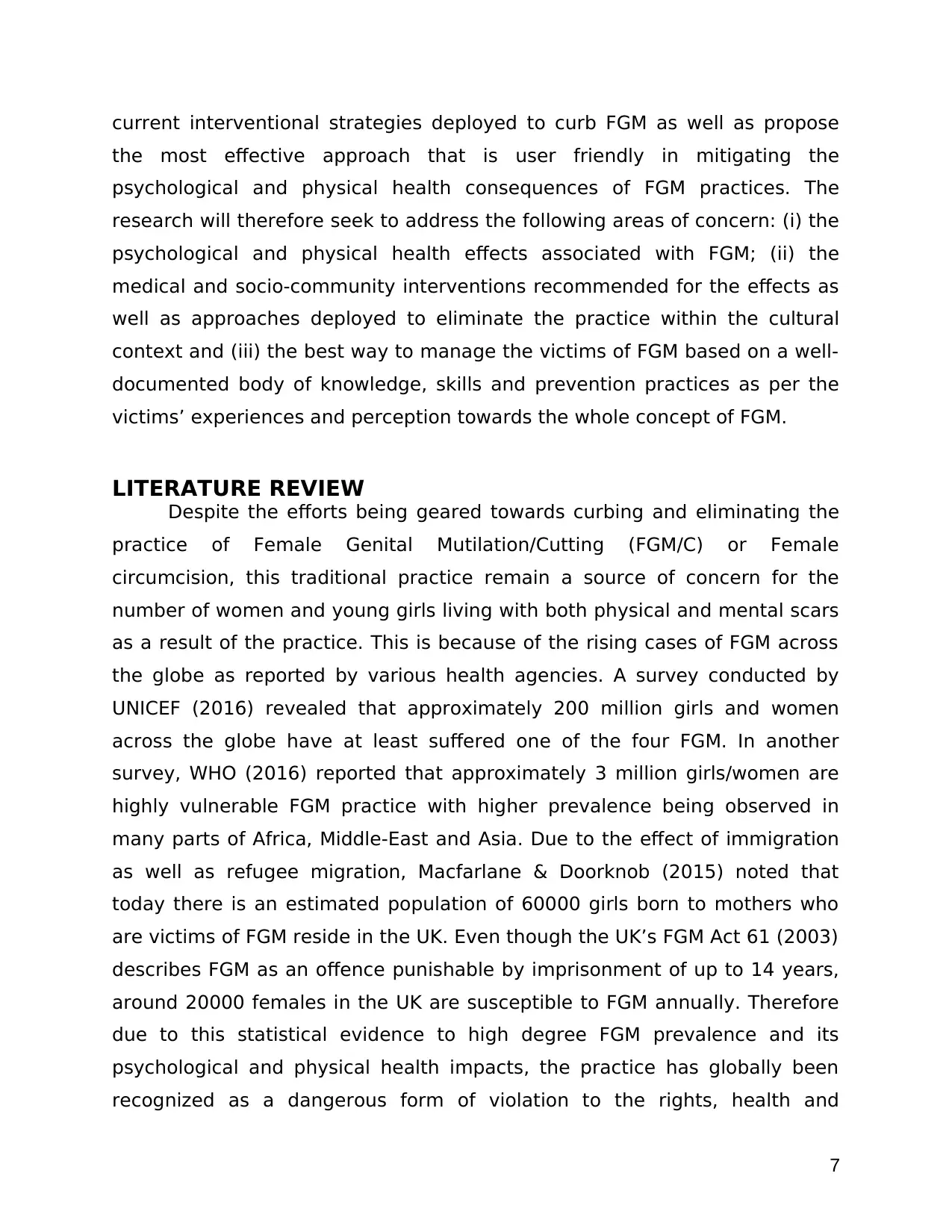
current interventional strategies deployed to curb FGM as well as propose
the most effective approach that is user friendly in mitigating the
psychological and physical health consequences of FGM practices. The
research will therefore seek to address the following areas of concern: (i) the
psychological and physical health effects associated with FGM; (ii) the
medical and socio-community interventions recommended for the effects as
well as approaches deployed to eliminate the practice within the cultural
context and (iii) the best way to manage the victims of FGM based on a well-
documented body of knowledge, skills and prevention practices as per the
victims’ experiences and perception towards the whole concept of FGM.
LITERATURE REVIEW
Despite the efforts being geared towards curbing and eliminating the
practice of Female Genital Mutilation/Cutting (FGM/C) or Female
circumcision, this traditional practice remain a source of concern for the
number of women and young girls living with both physical and mental scars
as a result of the practice. This is because of the rising cases of FGM across
the globe as reported by various health agencies. A survey conducted by
UNICEF (2016) revealed that approximately 200 million girls and women
across the globe have at least suffered one of the four FGM. In another
survey, WHO (2016) reported that approximately 3 million girls/women are
highly vulnerable FGM practice with higher prevalence being observed in
many parts of Africa, Middle-East and Asia. Due to the effect of immigration
as well as refugee migration, Macfarlane & Doorknob (2015) noted that
today there is an estimated population of 60000 girls born to mothers who
are victims of FGM reside in the UK. Even though the UK’s FGM Act 61 (2003)
describes FGM as an offence punishable by imprisonment of up to 14 years,
around 20000 females in the UK are susceptible to FGM annually. Therefore
due to this statistical evidence to high degree FGM prevalence and its
psychological and physical health impacts, the practice has globally been
recognized as a dangerous form of violation to the rights, health and
7
the most effective approach that is user friendly in mitigating the
psychological and physical health consequences of FGM practices. The
research will therefore seek to address the following areas of concern: (i) the
psychological and physical health effects associated with FGM; (ii) the
medical and socio-community interventions recommended for the effects as
well as approaches deployed to eliminate the practice within the cultural
context and (iii) the best way to manage the victims of FGM based on a well-
documented body of knowledge, skills and prevention practices as per the
victims’ experiences and perception towards the whole concept of FGM.
LITERATURE REVIEW
Despite the efforts being geared towards curbing and eliminating the
practice of Female Genital Mutilation/Cutting (FGM/C) or Female
circumcision, this traditional practice remain a source of concern for the
number of women and young girls living with both physical and mental scars
as a result of the practice. This is because of the rising cases of FGM across
the globe as reported by various health agencies. A survey conducted by
UNICEF (2016) revealed that approximately 200 million girls and women
across the globe have at least suffered one of the four FGM. In another
survey, WHO (2016) reported that approximately 3 million girls/women are
highly vulnerable FGM practice with higher prevalence being observed in
many parts of Africa, Middle-East and Asia. Due to the effect of immigration
as well as refugee migration, Macfarlane & Doorknob (2015) noted that
today there is an estimated population of 60000 girls born to mothers who
are victims of FGM reside in the UK. Even though the UK’s FGM Act 61 (2003)
describes FGM as an offence punishable by imprisonment of up to 14 years,
around 20000 females in the UK are susceptible to FGM annually. Therefore
due to this statistical evidence to high degree FGM prevalence and its
psychological and physical health impacts, the practice has globally been
recognized as a dangerous form of violation to the rights, health and
7
Paraphrase This Document
Need a fresh take? Get an instant paraphrase of this document with our AI Paraphraser
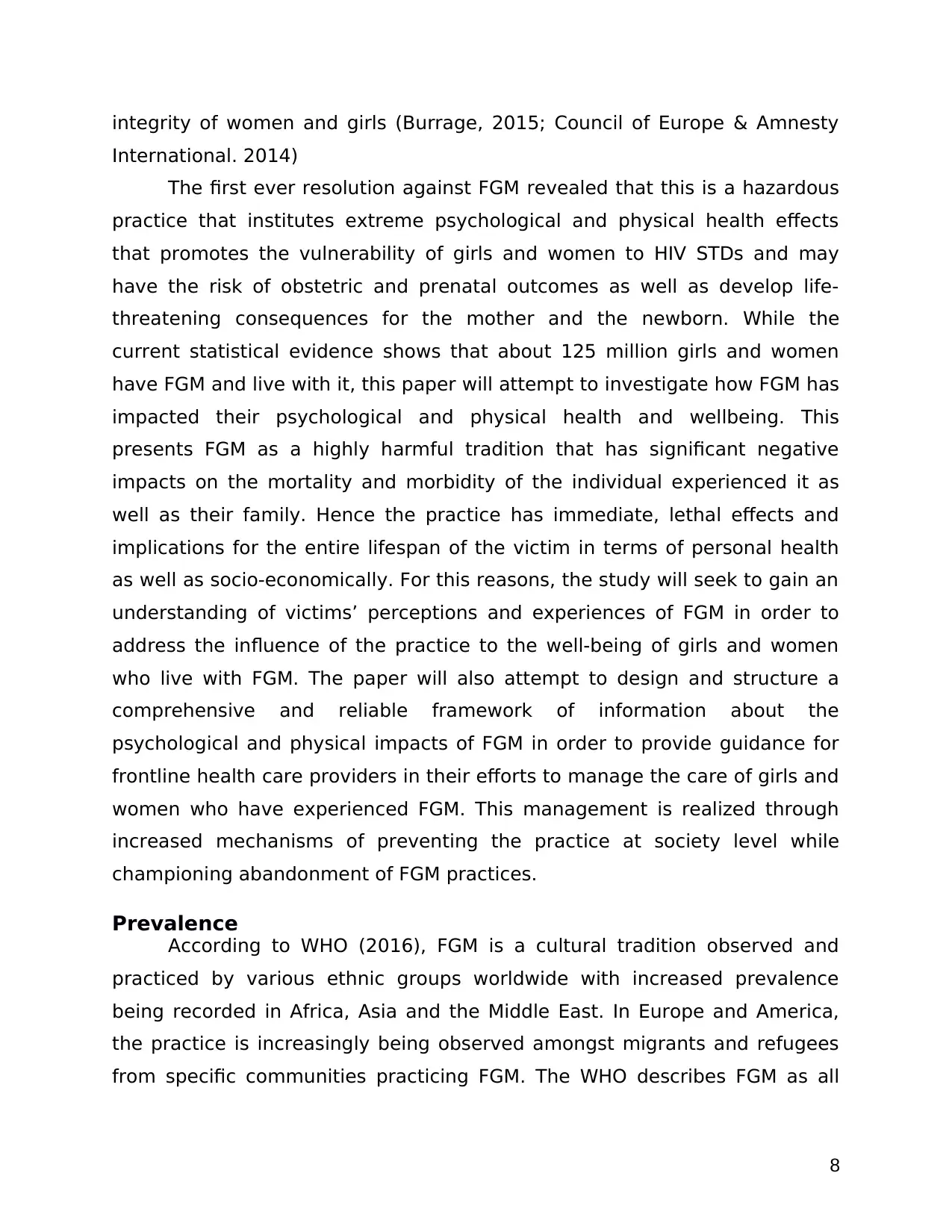
integrity of women and girls (Burrage, 2015; Council of Europe & Amnesty
International. 2014)
The first ever resolution against FGM revealed that this is a hazardous
practice that institutes extreme psychological and physical health effects
that promotes the vulnerability of girls and women to HIV STDs and may
have the risk of obstetric and prenatal outcomes as well as develop life-
threatening consequences for the mother and the newborn. While the
current statistical evidence shows that about 125 million girls and women
have FGM and live with it, this paper will attempt to investigate how FGM has
impacted their psychological and physical health and wellbeing. This
presents FGM as a highly harmful tradition that has significant negative
impacts on the mortality and morbidity of the individual experienced it as
well as their family. Hence the practice has immediate, lethal effects and
implications for the entire lifespan of the victim in terms of personal health
as well as socio-economically. For this reasons, the study will seek to gain an
understanding of victims’ perceptions and experiences of FGM in order to
address the influence of the practice to the well-being of girls and women
who live with FGM. The paper will also attempt to design and structure a
comprehensive and reliable framework of information about the
psychological and physical impacts of FGM in order to provide guidance for
frontline health care providers in their efforts to manage the care of girls and
women who have experienced FGM. This management is realized through
increased mechanisms of preventing the practice at society level while
championing abandonment of FGM practices.
Prevalence
According to WHO (2016), FGM is a cultural tradition observed and
practiced by various ethnic groups worldwide with increased prevalence
being recorded in Africa, Asia and the Middle East. In Europe and America,
the practice is increasingly being observed amongst migrants and refugees
from specific communities practicing FGM. The WHO describes FGM as all
8
International. 2014)
The first ever resolution against FGM revealed that this is a hazardous
practice that institutes extreme psychological and physical health effects
that promotes the vulnerability of girls and women to HIV STDs and may
have the risk of obstetric and prenatal outcomes as well as develop life-
threatening consequences for the mother and the newborn. While the
current statistical evidence shows that about 125 million girls and women
have FGM and live with it, this paper will attempt to investigate how FGM has
impacted their psychological and physical health and wellbeing. This
presents FGM as a highly harmful tradition that has significant negative
impacts on the mortality and morbidity of the individual experienced it as
well as their family. Hence the practice has immediate, lethal effects and
implications for the entire lifespan of the victim in terms of personal health
as well as socio-economically. For this reasons, the study will seek to gain an
understanding of victims’ perceptions and experiences of FGM in order to
address the influence of the practice to the well-being of girls and women
who live with FGM. The paper will also attempt to design and structure a
comprehensive and reliable framework of information about the
psychological and physical impacts of FGM in order to provide guidance for
frontline health care providers in their efforts to manage the care of girls and
women who have experienced FGM. This management is realized through
increased mechanisms of preventing the practice at society level while
championing abandonment of FGM practices.
Prevalence
According to WHO (2016), FGM is a cultural tradition observed and
practiced by various ethnic groups worldwide with increased prevalence
being recorded in Africa, Asia and the Middle East. In Europe and America,
the practice is increasingly being observed amongst migrants and refugees
from specific communities practicing FGM. The WHO describes FGM as all
8
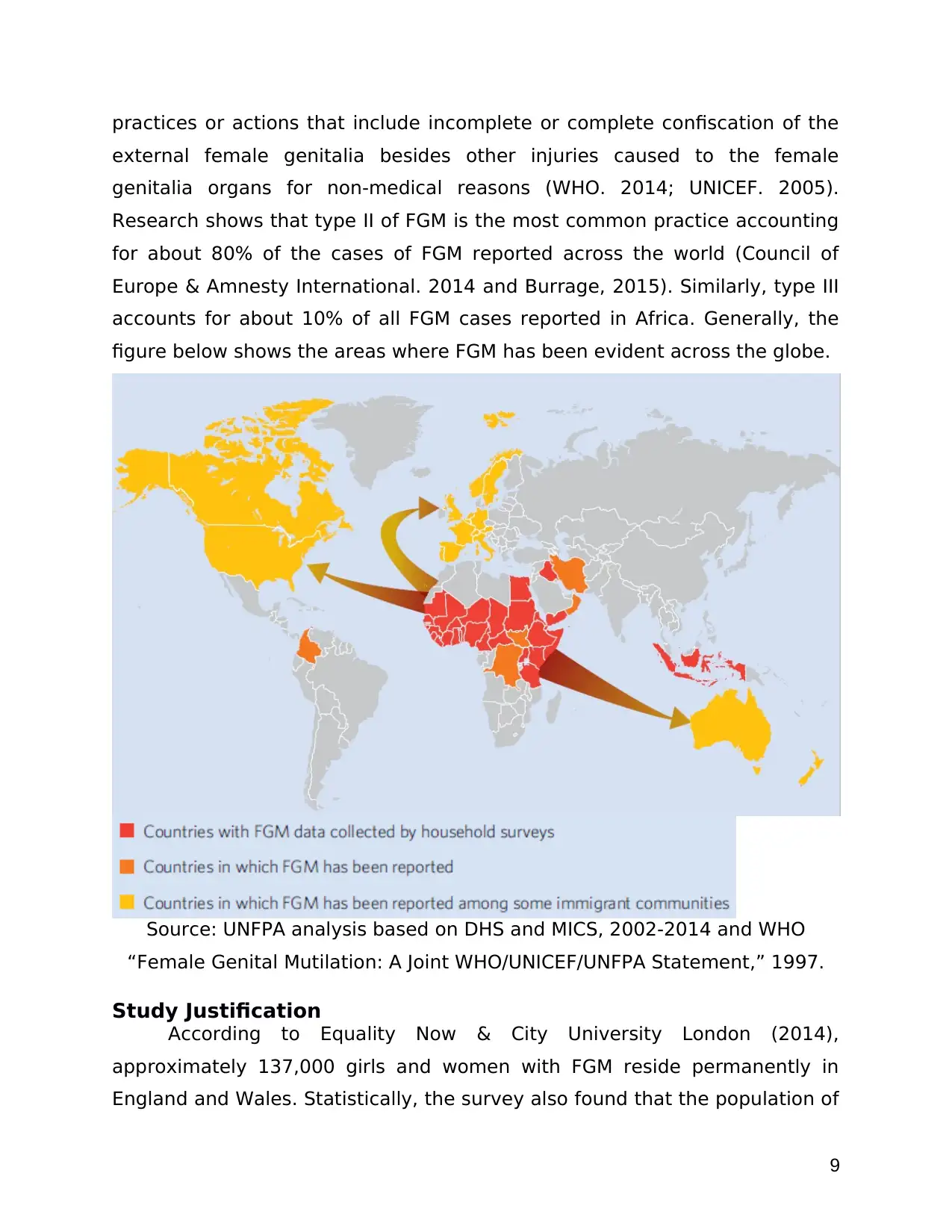
practices or actions that include incomplete or complete confiscation of the
external female genitalia besides other injuries caused to the female
genitalia organs for non-medical reasons (WHO. 2014; UNICEF. 2005).
Research shows that type II of FGM is the most common practice accounting
for about 80% of the cases of FGM reported across the world (Council of
Europe & Amnesty International. 2014 and Burrage, 2015). Similarly, type III
accounts for about 10% of all FGM cases reported in Africa. Generally, the
figure below shows the areas where FGM has been evident across the globe.
Source: UNFPA analysis based on DHS and MICS, 2002-2014 and WHO
“Female Genital Mutilation: A Joint WHO/UNICEF/UNFPA Statement,” 1997.
Study Justification
According to Equality Now & City University London (2014),
approximately 137,000 girls and women with FGM reside permanently in
England and Wales. Statistically, the survey also found that the population of
9
external female genitalia besides other injuries caused to the female
genitalia organs for non-medical reasons (WHO. 2014; UNICEF. 2005).
Research shows that type II of FGM is the most common practice accounting
for about 80% of the cases of FGM reported across the world (Council of
Europe & Amnesty International. 2014 and Burrage, 2015). Similarly, type III
accounts for about 10% of all FGM cases reported in Africa. Generally, the
figure below shows the areas where FGM has been evident across the globe.
Source: UNFPA analysis based on DHS and MICS, 2002-2014 and WHO
“Female Genital Mutilation: A Joint WHO/UNICEF/UNFPA Statement,” 1997.
Study Justification
According to Equality Now & City University London (2014),
approximately 137,000 girls and women with FGM reside permanently in
England and Wales. Statistically, the survey also found that the population of
9
⊘ This is a preview!⊘
Do you want full access?
Subscribe today to unlock all pages.

Trusted by 1+ million students worldwide
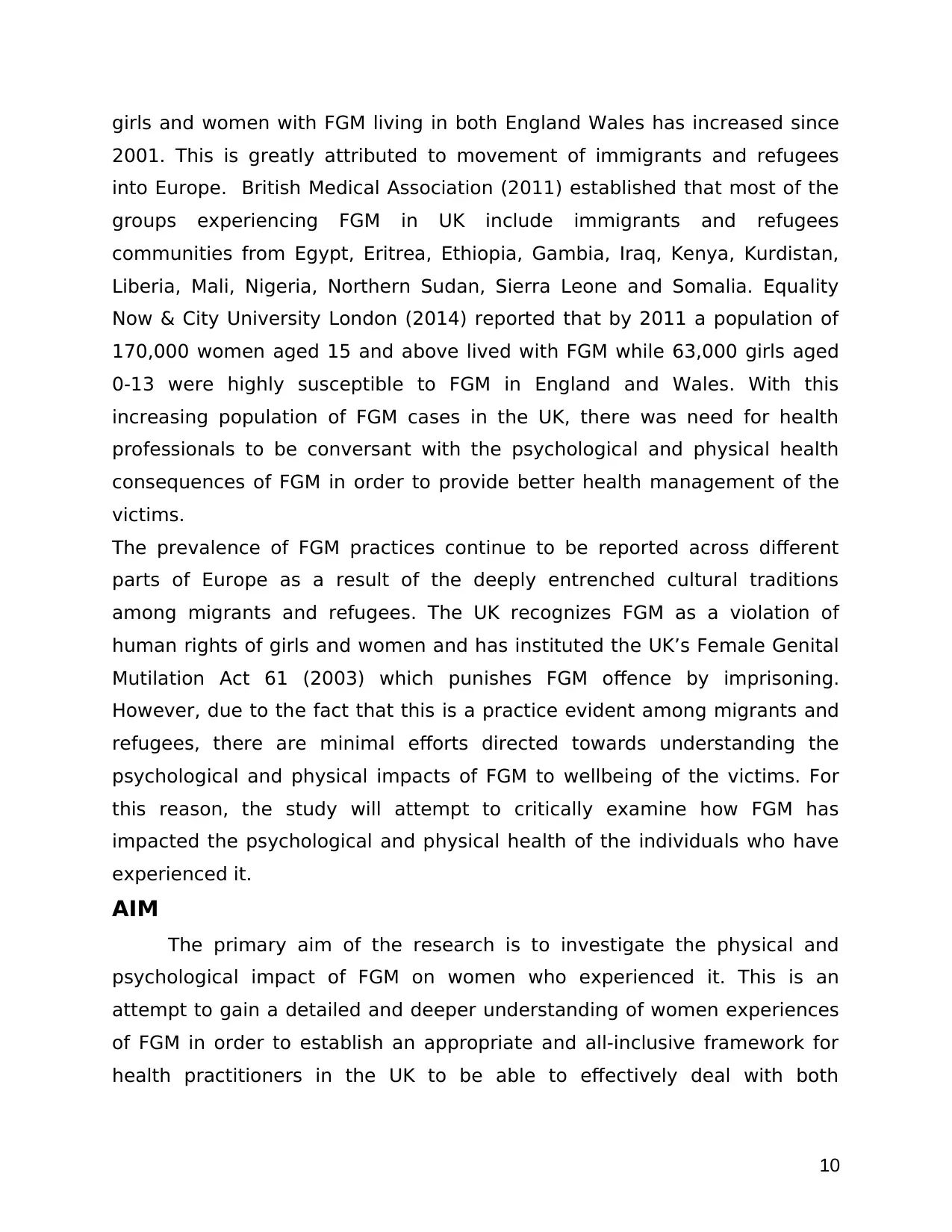
girls and women with FGM living in both England Wales has increased since
2001. This is greatly attributed to movement of immigrants and refugees
into Europe. British Medical Association (2011) established that most of the
groups experiencing FGM in UK include immigrants and refugees
communities from Egypt, Eritrea, Ethiopia, Gambia, Iraq, Kenya, Kurdistan,
Liberia, Mali, Nigeria, Northern Sudan, Sierra Leone and Somalia. Equality
Now & City University London (2014) reported that by 2011 a population of
170,000 women aged 15 and above lived with FGM while 63,000 girls aged
0-13 were highly susceptible to FGM in England and Wales. With this
increasing population of FGM cases in the UK, there was need for health
professionals to be conversant with the psychological and physical health
consequences of FGM in order to provide better health management of the
victims.
The prevalence of FGM practices continue to be reported across different
parts of Europe as a result of the deeply entrenched cultural traditions
among migrants and refugees. The UK recognizes FGM as a violation of
human rights of girls and women and has instituted the UK’s Female Genital
Mutilation Act 61 (2003) which punishes FGM offence by imprisoning.
However, due to the fact that this is a practice evident among migrants and
refugees, there are minimal efforts directed towards understanding the
psychological and physical impacts of FGM to wellbeing of the victims. For
this reason, the study will attempt to critically examine how FGM has
impacted the psychological and physical health of the individuals who have
experienced it.
AIM
The primary aim of the research is to investigate the physical and
psychological impact of FGM on women who experienced it. This is an
attempt to gain a detailed and deeper understanding of women experiences
of FGM in order to establish an appropriate and all-inclusive framework for
health practitioners in the UK to be able to effectively deal with both
10
2001. This is greatly attributed to movement of immigrants and refugees
into Europe. British Medical Association (2011) established that most of the
groups experiencing FGM in UK include immigrants and refugees
communities from Egypt, Eritrea, Ethiopia, Gambia, Iraq, Kenya, Kurdistan,
Liberia, Mali, Nigeria, Northern Sudan, Sierra Leone and Somalia. Equality
Now & City University London (2014) reported that by 2011 a population of
170,000 women aged 15 and above lived with FGM while 63,000 girls aged
0-13 were highly susceptible to FGM in England and Wales. With this
increasing population of FGM cases in the UK, there was need for health
professionals to be conversant with the psychological and physical health
consequences of FGM in order to provide better health management of the
victims.
The prevalence of FGM practices continue to be reported across different
parts of Europe as a result of the deeply entrenched cultural traditions
among migrants and refugees. The UK recognizes FGM as a violation of
human rights of girls and women and has instituted the UK’s Female Genital
Mutilation Act 61 (2003) which punishes FGM offence by imprisoning.
However, due to the fact that this is a practice evident among migrants and
refugees, there are minimal efforts directed towards understanding the
psychological and physical impacts of FGM to wellbeing of the victims. For
this reason, the study will attempt to critically examine how FGM has
impacted the psychological and physical health of the individuals who have
experienced it.
AIM
The primary aim of the research is to investigate the physical and
psychological impact of FGM on women who experienced it. This is an
attempt to gain a detailed and deeper understanding of women experiences
of FGM in order to establish an appropriate and all-inclusive framework for
health practitioners in the UK to be able to effectively deal with both
10
Paraphrase This Document
Need a fresh take? Get an instant paraphrase of this document with our AI Paraphraser
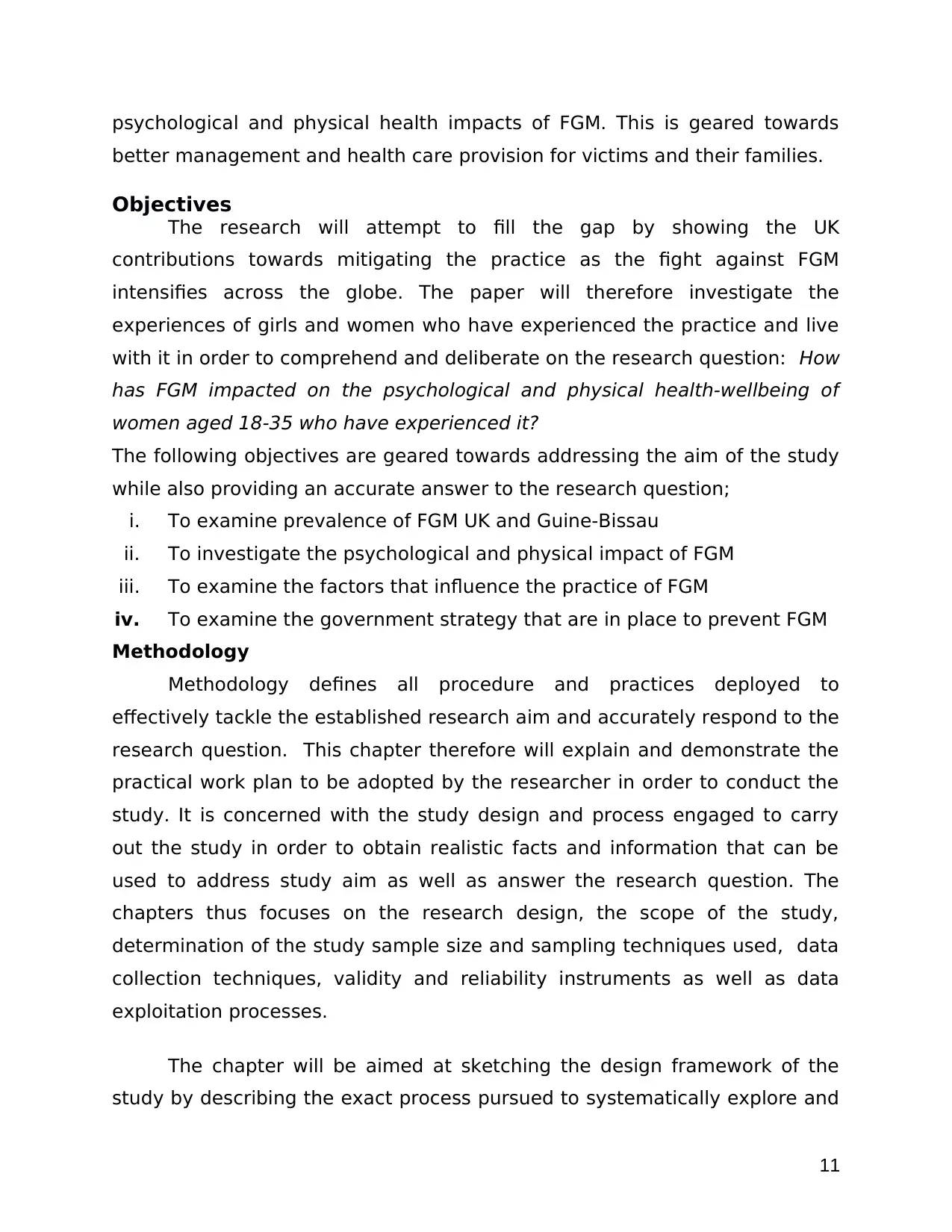
psychological and physical health impacts of FGM. This is geared towards
better management and health care provision for victims and their families.
Objectives
The research will attempt to fill the gap by showing the UK
contributions towards mitigating the practice as the fight against FGM
intensifies across the globe. The paper will therefore investigate the
experiences of girls and women who have experienced the practice and live
with it in order to comprehend and deliberate on the research question: How
has FGM impacted on the psychological and physical health-wellbeing of
women aged 18-35 who have experienced it?
The following objectives are geared towards addressing the aim of the study
while also providing an accurate answer to the research question;
i. To examine prevalence of FGM UK and Guine-Bissau
ii. To investigate the psychological and physical impact of FGM
iii. To examine the factors that influence the practice of FGM
iv. To examine the government strategy that are in place to prevent FGM
Methodology
Methodology defines all procedure and practices deployed to
effectively tackle the established research aim and accurately respond to the
research question. This chapter therefore will explain and demonstrate the
practical work plan to be adopted by the researcher in order to conduct the
study. It is concerned with the study design and process engaged to carry
out the study in order to obtain realistic facts and information that can be
used to address study aim as well as answer the research question. The
chapters thus focuses on the research design, the scope of the study,
determination of the study sample size and sampling techniques used, data
collection techniques, validity and reliability instruments as well as data
exploitation processes.
The chapter will be aimed at sketching the design framework of the
study by describing the exact process pursued to systematically explore and
11
better management and health care provision for victims and their families.
Objectives
The research will attempt to fill the gap by showing the UK
contributions towards mitigating the practice as the fight against FGM
intensifies across the globe. The paper will therefore investigate the
experiences of girls and women who have experienced the practice and live
with it in order to comprehend and deliberate on the research question: How
has FGM impacted on the psychological and physical health-wellbeing of
women aged 18-35 who have experienced it?
The following objectives are geared towards addressing the aim of the study
while also providing an accurate answer to the research question;
i. To examine prevalence of FGM UK and Guine-Bissau
ii. To investigate the psychological and physical impact of FGM
iii. To examine the factors that influence the practice of FGM
iv. To examine the government strategy that are in place to prevent FGM
Methodology
Methodology defines all procedure and practices deployed to
effectively tackle the established research aim and accurately respond to the
research question. This chapter therefore will explain and demonstrate the
practical work plan to be adopted by the researcher in order to conduct the
study. It is concerned with the study design and process engaged to carry
out the study in order to obtain realistic facts and information that can be
used to address study aim as well as answer the research question. The
chapters thus focuses on the research design, the scope of the study,
determination of the study sample size and sampling techniques used, data
collection techniques, validity and reliability instruments as well as data
exploitation processes.
The chapter will be aimed at sketching the design framework of the
study by describing the exact process pursued to systematically explore and
11
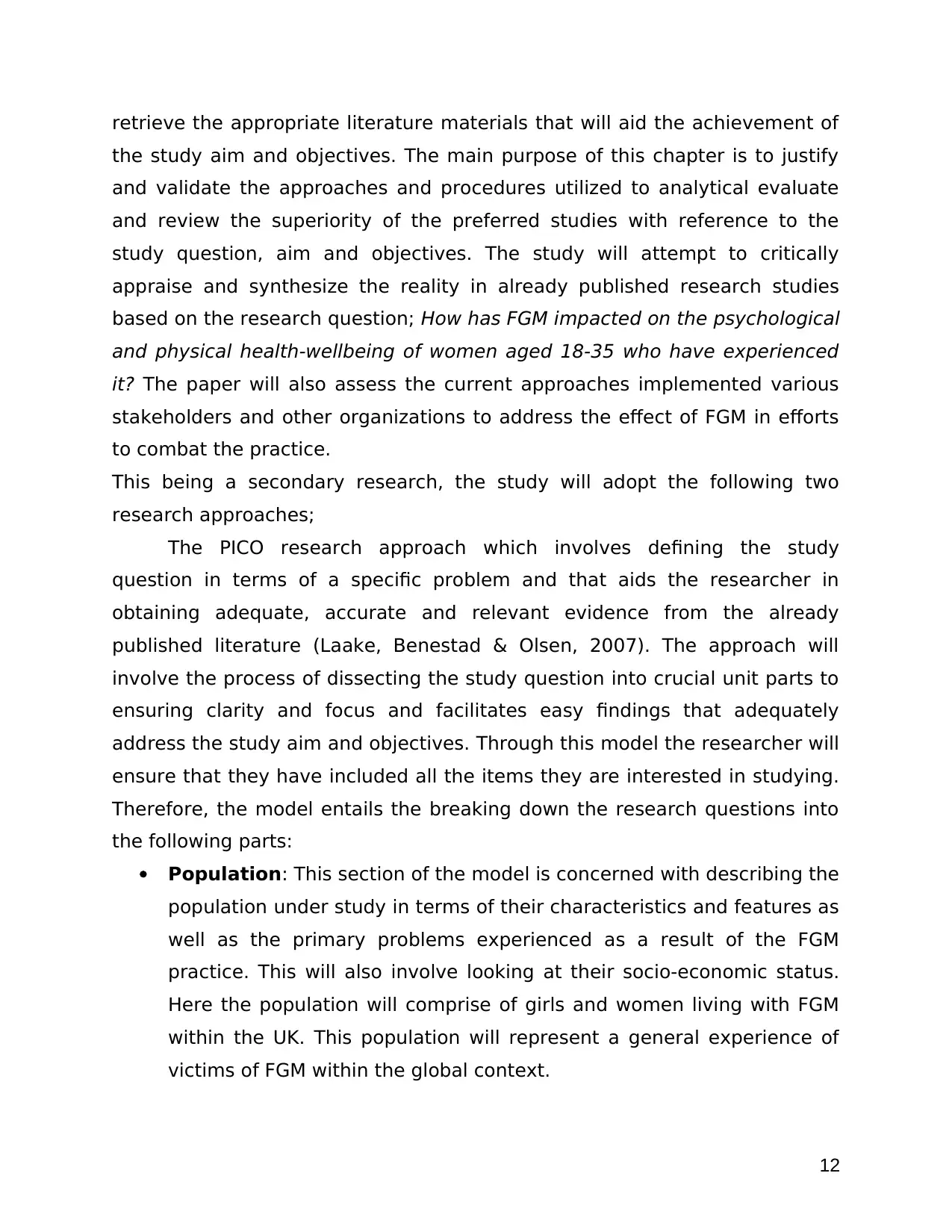
retrieve the appropriate literature materials that will aid the achievement of
the study aim and objectives. The main purpose of this chapter is to justify
and validate the approaches and procedures utilized to analytical evaluate
and review the superiority of the preferred studies with reference to the
study question, aim and objectives. The study will attempt to critically
appraise and synthesize the reality in already published research studies
based on the research question; How has FGM impacted on the psychological
and physical health-wellbeing of women aged 18-35 who have experienced
it? The paper will also assess the current approaches implemented various
stakeholders and other organizations to address the effect of FGM in efforts
to combat the practice.
This being a secondary research, the study will adopt the following two
research approaches;
The PICO research approach which involves defining the study
question in terms of a specific problem and that aids the researcher in
obtaining adequate, accurate and relevant evidence from the already
published literature (Laake, Benestad & Olsen, 2007). The approach will
involve the process of dissecting the study question into crucial unit parts to
ensuring clarity and focus and facilitates easy findings that adequately
address the study aim and objectives. Through this model the researcher will
ensure that they have included all the items they are interested in studying.
Therefore, the model entails the breaking down the research questions into
the following parts:
Population: This section of the model is concerned with describing the
population under study in terms of their characteristics and features as
well as the primary problems experienced as a result of the FGM
practice. This will also involve looking at their socio-economic status.
Here the population will comprise of girls and women living with FGM
within the UK. This population will represent a general experience of
victims of FGM within the global context.
12
the study aim and objectives. The main purpose of this chapter is to justify
and validate the approaches and procedures utilized to analytical evaluate
and review the superiority of the preferred studies with reference to the
study question, aim and objectives. The study will attempt to critically
appraise and synthesize the reality in already published research studies
based on the research question; How has FGM impacted on the psychological
and physical health-wellbeing of women aged 18-35 who have experienced
it? The paper will also assess the current approaches implemented various
stakeholders and other organizations to address the effect of FGM in efforts
to combat the practice.
This being a secondary research, the study will adopt the following two
research approaches;
The PICO research approach which involves defining the study
question in terms of a specific problem and that aids the researcher in
obtaining adequate, accurate and relevant evidence from the already
published literature (Laake, Benestad & Olsen, 2007). The approach will
involve the process of dissecting the study question into crucial unit parts to
ensuring clarity and focus and facilitates easy findings that adequately
address the study aim and objectives. Through this model the researcher will
ensure that they have included all the items they are interested in studying.
Therefore, the model entails the breaking down the research questions into
the following parts:
Population: This section of the model is concerned with describing the
population under study in terms of their characteristics and features as
well as the primary problems experienced as a result of the FGM
practice. This will also involve looking at their socio-economic status.
Here the population will comprise of girls and women living with FGM
within the UK. This population will represent a general experience of
victims of FGM within the global context.
12
⊘ This is a preview!⊘
Do you want full access?
Subscribe today to unlock all pages.

Trusted by 1+ million students worldwide
1 out of 19
Related Documents
Your All-in-One AI-Powered Toolkit for Academic Success.
+13062052269
info@desklib.com
Available 24*7 on WhatsApp / Email
![[object Object]](/_next/static/media/star-bottom.7253800d.svg)
Unlock your academic potential
Copyright © 2020–2025 A2Z Services. All Rights Reserved. Developed and managed by ZUCOL.



